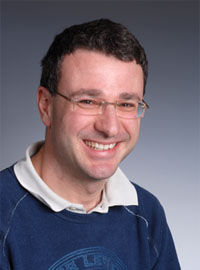Davide Marenduzzo

Professor D Marenduzzo
- Position
- Personal Chair in Computational Biophysics
- Category
- Academic staff
- Location
-
James Clerk Maxwell Building (JCMB)
Room 2506
- Email: Davide.Marenduzzo [at] ed.ac.uk
- Tel: +44 (0)131 650 5289
- Personal home page
- Edinburgh Research Explorer profile
Davide is a member of the following School research institute and research areas:
Research interests
The problems I am interested in are in the area of biological physics and soft condensed matter physics.
In biological physics, I am interested in modelling DNA at several levels of complexity, either within bacteria or in eukaryotes, where it is associated with histones to form chromatin, and, at a larger scale, chromosomes. I am currently actively researching the spatial organisation of chromosomes, the self-assembly of chromatin fibers and their higher order organisation, and the physics of DNA organisation in bacteria. For all these projects I am using large scale computer simulations, and I collaborate with experimentalists in Edinburgh, UK and Europe. Our methods are Brownian dynamics simulations, and we are also working to incorporate hydrodynamic interactions in our molecular dynamics calculations. Still in biological physics, I have an ongoing interest in modelling cell motility and cytoskeletal dynamics, and I am also working actively on the physics of self-propelled particles and active matter. For most of the projects I also have collaborators within Physics.
In soft matter, I am interested in liquid crystals and related materials. Currently together with M. E. Cates, K. Stratford and O. Henrich we are developing large scale simulation methods to study emulsions (droplets of water in liquid crystals, or of liquid crystals in water), as well as colloid-liquid crystal composites (also with experimentalists in the group, P. S. Clegg, T. A. Wood, A. C. Pawsey and W. C. K. Poon among others). Projects of interest address the phase beheviour, hydrodynamics, rheology and electric-field switching of these liquid crystal based materials.
Currently I teach two courses for undergraduate students at the School of Physics. The first, Advanced Statistical Physics, is the third statistical physics module, meant for year 5 undergraduates who have an interest in this topic. The course covers mean field theories of phase transition, the renormalisation group in real space, and some aspects of nonequilibrium statistical physics (random walk, the Langevin and Fokker-Planck equation). The second course is a year 4 course on modelling via computer simulations (Modelling and Visualisation in Physics), and teaches student to use their language of choice (typically Java in Edinburgh) to set up and solve a physical problems. Examples which are worked out during the course are the Ising model in 2D, the Lennard-Jones fluid, and the Poisson equation of electrostatics. I have been a Personal Tutor for about 3 years now, and my task in this role is to direct students in various years of their degrees when choosing their courses, as well as to be a first point of contact in case they are struggling with some issues. Finally, at postgraduate level together with R. A. Blythe I teach a SUPA course, Nonequilibrium statistical mechanics, which runs every other year.
Davide currently offers the following PhD project opportunities:
Davide has featured in the following recent School news stories:
Recent publications
- , Journal of Theoretical Biology, 611, p. 1-12
- , Soft Matter, 21, 35, p. 6975-6983
- , Soft Matter, 20, 26, p. 5296-5311
- , Nucleus, 16, 1, p. 1-10
- , Physical Review Letters, 134, 18, p. 1-6

